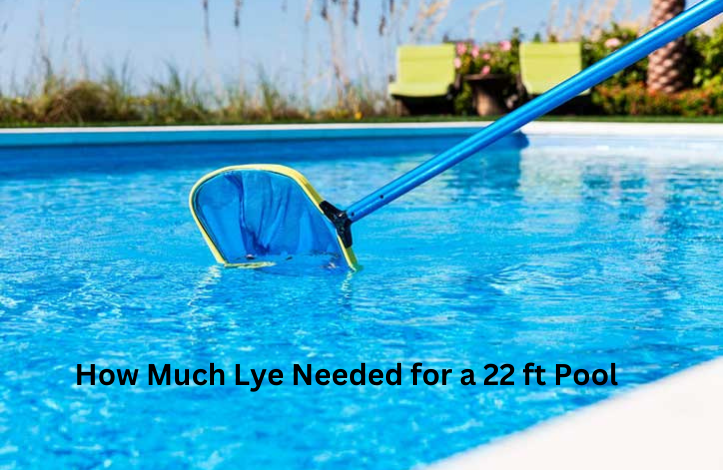How Much Lye Needed for a 22 ft Pool: A Complete Guide

Introduction
Maintaining the ideal chemical balance in your pool is essential for a safe and enjoyable swimming environment. One critical component in achieving the right pool chemistry is lye, or sodium hydroxide. Adding the correct amount of lye is vital, as it plays a key role in controlling the pH level of the pool water. If you’re wondering how much lye is needed for a 22 ft pool, this guide will break down everything you need to know, from calculating the amount to applying it safely. This article will answer common questions, provide an overview of why lye is important, and offer essential tips for perfect pool maintenance.
What is Lye, and Why is It Important for Pool Maintenance?
Lye, also known as sodium hydroxide, is a powerful alkaline substance commonly used in pool maintenance. Its primary purpose in pools is to increase pH levels, which helps keep the water balanced. The pH level is a measure of the acidity or alkalinity of the water, and it’s crucial to maintain it between 7.2 and 7.8 for an optimal swimming experience.
Using lye in your pool offers several benefits:
- Prevents Corrosion: Low pH levels can make pool water acidic, leading to corrosion of pool surfaces, pipes, and equipment.
- Protects Swimmers: Properly balanced pH levels prevent skin and eye irritation in swimmers.
- Enhances Chlorine Efficiency: Chlorine works best in a balanced pH environment, maximizing its ability to kill bacteria and keep the pool water clear and safe.
For a 22 ft pool, the amount of lye needed depends on various factors, including the pool’s volume and the current pH level. This guide will cover the steps to calculate the correct lye dosage and how to apply it effectively.
Calculating Pool Volume for a 22 ft Pool
Before determining the amount of lye needed, it’s essential to know the pool’s volume. Pool volume is usually measured in gallons, and for a 22 ft pool, you can use the following formula:
- Round Pools:
- Formula: Volume=π×Radius2×Average Depth×7.48\text{Volume} = \pi \times \text{Radius}^2 \times \text{Average Depth} \times 7.48Volume=π×Radius2×Average Depth×7.48
- Example Calculation: If the diameter is 22 feet, then the radius is 11 feet. For an average depth of 4 feet, the volume is approximately 11,412 gallons.
- Oval Pools:
- Formula: Volume=Length×Width×Average Depth×5.9\text{Volume} = \text{Length} \times \text{Width} \times \text{Average Depth} \times 5.9Volume=Length×Width×Average Depth×5.9
- Example Calculation: For an oval pool 22 feet long and 15 feet wide with an average depth of 4 feet, the volume is around 7,788 gallons.
Once you have the pool’s volume, you can proceed with calculating the lye amount needed.
How Much Lye Needed for a 22 ft Pool
To determine the exact amount of lye required, you’ll need to test the current pH level of the pool water. Pool pH test kits are readily available and provide an accurate reading. If your pool’s pH level is below the ideal range of 7.2 to 7.8, adding lye can help increase it.
General Guidelines for Adding Lye
- For every 10,000 gallons of water, approximately 1 oz of lye can raise the pH by about 0.2.
- Start by adding a small amount, around 0.5 oz per 5,000 gallons, and then test the pH level.
- Continue adjusting in small increments until you reach the desired pH level.
In the case of a 22 ft pool with an approximate volume of 11,000 gallons, you may need about 1.1 oz of lye to raise the pH by 0.2. However, this amount can vary depending on the initial pH level and the pool’s specific needs.
Step-by-Step Guide for Adding Lye to Your Pool
- Test the Current pH Level: Use a reliable test kit to check your pool’s pH.
- Calculate the Required Lye Amount: Based on your pool’s volume and the pH test results, calculate the amount of lye needed.
- Dilute the Lye: Lye is highly caustic, so it’s essential to dilute it with water before adding it to the pool.
- Add Lye to the Pool: Pour the diluted solution evenly around the pool to ensure even distribution.
- Allow Circulation: Run the pool pump for at least 2 hours to circulate the lye throughout the pool.
- Re-test the pH: After a few hours, re-test the pH level to confirm it is within the 7.2-7.8 range.
Common Mistakes to Avoid When Adding Lye
- Adding Too Much Lye at Once: Always start with small doses to avoid overshooting the ideal pH level.
- Not Wearing Safety Gear: Lye can cause burns on the skin and damage to eyes. Always wear gloves and goggles when handling it.
- Not Allowing Enough Circulation Time: The pool pump should be running to ensure the lye is evenly dispersed in the water.
- Skipping pH Re-testing: Testing after adding lye helps ensure you don’t need further adjustments.
Alternative Methods for pH Adjustment in Pools
If you prefer not to use lye, there are alternative options for raising pool pH:
- Baking Soda (Sodium Bicarbonate): While it’s not as potent as lye, baking soda can raise both the pH and alkalinity levels.
- Soda Ash (Sodium Carbonate): Soda ash is another strong alkaline substance, effective for increasing pH without the harshness of lye.
- Aeration: In some cases, aerating the pool (such as with a fountain or pool jets) can naturally raise the pH without adding chemicals.
Each of these alternatives has different effects on pool chemistry, so consult a pool maintenance expert to determine the best option for your needs.
FAQs
1. How much lye is needed for a 22 ft pool?
The amount of lye needed depends on your pool’s volume and current pH level. For a 22 ft pool with approximately 11,000 gallons, about 1.1 oz of lye can raise the pH by 0.2. However, always start with small doses and re-test the pH level to avoid over-adjusting.
2. How often should I add lye to my pool?
Lye is typically added only when the pH level falls below 7.2. Regularly test your pool’s pH (at least once a week) to determine if adjustments are needed.
3. Can I add lye to my pool directly, or should I dilute it first?
Lye should always be diluted with water before adding it to the pool. Directly adding lye can result in uneven distribution and can damage the pool liner or surfaces.
4. What are the risks of adding too much lye?
Excessive lye can raise the pH above 7.8, making the water too alkaline. This can lead to cloudy water, scaling, and ineffective chlorine. Overuse of lye may also result in eye and skin irritation for swimmers.
5. Are there safer alternatives to lye for raising pool pH?
Yes, other products like baking soda and soda ash are safer and effective alternatives for raising pH. Baking soda affects alkalinity, while soda ash directly impacts pH without the harshness of lye.
6. Does lye affect the chlorine levels in the pool?
Lye primarily affects pH and does not directly impact chlorine levels. However, pH levels outside the ideal range (7.2-7.8) can reduce chlorine’s effectiveness, indirectly affecting water sanitation.
Conclusion
Knowing how much lye is needed for a 22 ft pool is crucial for maintaining balanced, swimmer-safe water. Start by calculating your pool’s volume, then test the pH to determine the correct amount of lye needed. Adding lye in small increments, wearing protective gear, and regularly testing the water are essential for safe and effective pool maintenance. By keeping a close eye on your pool’s pH levels, you can ensure a clean, safe, and enjoyable swimming environment.
With these steps, you’ll be well-equipped to keep your 22 ft pool in excellent condition all season long!
4o




